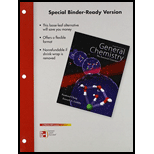
(a)
Interpretation:
The overall reaction for given two steps has to be written.
Concept introduction:
- The overall reaction is the reaction that comprises of the steps of mechanism.
- The rate law of a reaction cannot be predicted from the mechanistic steps. It is possible only with the overall reaction.
- Thus the overall reaction of the mechanistic steps is necessary to determine.
- It can be determined by simply adding up the mechanistic steps by cancelling out the similar chemical species on the opposite sides.
(b)
Interpretation:
The roles of
Concept introduction:
A catalyst is a substance that enhances the
Intermediate is a substance that will be produced in one step and combines with another reactant in another step to form the product. It is the species that links the steps of the mechanism. It is neither an initiator nor an end product. It is formed in between the reaction. Therefore, it is named as intermediate.
(c)
Interpretation:
The reason for fluorine radical is not important in the given mechanism has to be explained.
Concept introduction:
Depletion of ozone:
The chlorofluoro carbon is decomposed by the UV radiation and forms two products as shown below:
Among the two products, the chlorine is formed as radical. Radical are species with an unpaired electron. So radical are highly reactive species. Therefore, the chlorine radical reacts with ozone and causes the depletion of ozone.
(d)
Interpretation:
One suggestion to reduce the concentration of chlorine radicals is to add hydrocarbons such as ethane to the stratosphere. How this will work has to be explained.
Concept introduction:
Depletion of ozone:
The chlorofluoro carbon is decomposed by the UV radiation and forms two products as shown below:
Among the two products, the chlorine is formed as radical. Radical are species with an unpaired electron. So radical are highly reactive species. Therefore, the chlorine radical reacts with ozone and causes the depletion of ozone.
Want to see the full answer?
Check out a sample textbook solution
Chapter 14 Solutions
Loose Leaf For General Chemistry With Connect Access Card
 ChemistryChemistryISBN:9781305957404Author:Steven S. Zumdahl, Susan A. Zumdahl, Donald J. DeCostePublisher:Cengage Learning
ChemistryChemistryISBN:9781305957404Author:Steven S. Zumdahl, Susan A. Zumdahl, Donald J. DeCostePublisher:Cengage Learning ChemistryChemistryISBN:9781259911156Author:Raymond Chang Dr., Jason Overby ProfessorPublisher:McGraw-Hill Education
ChemistryChemistryISBN:9781259911156Author:Raymond Chang Dr., Jason Overby ProfessorPublisher:McGraw-Hill Education Principles of Instrumental AnalysisChemistryISBN:9781305577213Author:Douglas A. Skoog, F. James Holler, Stanley R. CrouchPublisher:Cengage Learning
Principles of Instrumental AnalysisChemistryISBN:9781305577213Author:Douglas A. Skoog, F. James Holler, Stanley R. CrouchPublisher:Cengage Learning Organic ChemistryChemistryISBN:9780078021558Author:Janice Gorzynski Smith Dr.Publisher:McGraw-Hill Education
Organic ChemistryChemistryISBN:9780078021558Author:Janice Gorzynski Smith Dr.Publisher:McGraw-Hill Education Chemistry: Principles and ReactionsChemistryISBN:9781305079373Author:William L. Masterton, Cecile N. HurleyPublisher:Cengage Learning
Chemistry: Principles and ReactionsChemistryISBN:9781305079373Author:William L. Masterton, Cecile N. HurleyPublisher:Cengage Learning Elementary Principles of Chemical Processes, Bind...ChemistryISBN:9781118431221Author:Richard M. Felder, Ronald W. Rousseau, Lisa G. BullardPublisher:WILEY
Elementary Principles of Chemical Processes, Bind...ChemistryISBN:9781118431221Author:Richard M. Felder, Ronald W. Rousseau, Lisa G. BullardPublisher:WILEY





